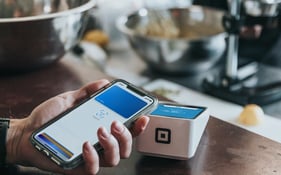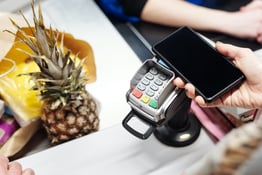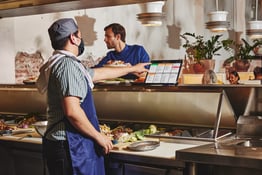—Cloud kitchen: you’ve probably heard this term and scratched your head a little. The name doesn’t really clarify what this new restaurant trend is. And yet, in 2019, investors poured over $2.9 billion into these hospitality models. Let’s demystify cloud kitchens and dig into what they mean for the future of restaurants.
What is a cloud kitchen?
They go by many names: cloud kitchens, ghost kitchens, dark kitchens, virtual kitchens, dark restaurants, digital restaurants. No matter what you call them, they are all (broadly) the same thing: a food-service business that only offers delivery or dine-out options. While it is a licensed space, no area of the restaurant is customer-facing. Instead, all transactions and orders happen online. Think of it this way: if your restaurant had no indoor or outdoor seating, no sign out front, no window for pickup and no physical branding anywhere inside or out, it would be a cloud kitchen.
Not only can cloud kitchens exist without a public-facing physical space, but one cloud kitchen can be home to many different food-service concepts, or virtual restaurants. The same kitchen can make food for a "taco restaurant" and an "Italian bistro." Sometimes it’s the same chefs, other times the same space is rented out to multiple dark restaurants who operate simultaneously. Cloud kitchens can be housed anywhere from large warehouses made with shared kitchen equipment to small trailers stationed in parking lots. No matter where they reside, a cloud or ghost kitchen can only get their food to a customer by way of an app food delivery service.
COVID-19 & why cloud kitchens are here to stay
When COVID-19 hit the U.S. most restaurants had to shut down indoor dining. For many, this meant pivoting their focus to delivery. In fact, 42% of restaurants added online ordering options as a result of the pandemic. Consumers have responded in kind, by increasingly ordering take-out orders and even bumping up the average delivery check size about 20%.
The pandemic has not only normalized online ordering, but it has demonstrated that restaurants can survive without a brick-and-mortar. With all interactions being digital, restaurants can consider doing away with costs such as rent, wait staff, tables, etc. and focus just on getting their food into people’s homes. Cloud kitchens have a business model that is made to thrive in our current landscape. Even when the glorious day arrives when COVID-19 comes to an end, these habits will be ingrained into consumer behaviors for the long run.
What to know about delivery services
Cloud kitchens are predicted to become a $1 trillion opportunity by 2030, and the only way to get there is through delivery. The delivery app is what allows ghost kitchens to operate exclusively from a shared kitchen space. It is the only line of communication connecting the restaurant to the customer and vice versa. This can be a little problematic because it essentially means you will not have direct ownership of your customer relationship; the delivery app will. The delivery app will also have control of the data and contact information that is collected.
This is all to say, choose a delivery partner that is truly a partner, one that isn’t going to eat your margins, misdirect consumers and mistreat their workforce. Otherwise, you risk losing complete control of your customer experience, not to mention your profits. To play it safe here is some guidance on what to look for:
DON’T partner with a delivery service that is going to take large commission fees. It will only hurt your bottom line. In some case, delivery platforms will take up to 30%.
DO partner with a platform that gives you control of your data and your listing information. Ideally, you have the ability to control how and what you display on the delivery app, plus get insights into where your customers are, what they are ordering, their contact information, etc.
DO use a delivery service that has robust promotional capabilities, but that also doesn’t charge you an arm and a leg for the service. Remember, your restaurant will live exclusively online so you want a platform that can help you reach new customers easily and without crazy fees.
DON’T go with a delivery platform that doesn’t communicate well with your kitchen. The app should offer a clear hub be it through a tablet, your POS or a website that is going to give notifications in a clear manner. Orders should be easy for the kitchen to organize, just as they would need to be in a traditional BOH setting.
DO see what your peers recommend. Getting a second opinion, be it on the phone or through reviews is an excellent way to explore what is really going to work for your cloud kitchen.
How to promote a cloud kitchen restaurant
While your cloud kitchen may not have a FOH staff, you should definitely consider investing in good marketing to promote your digital restaurant. Start with setting up and building out social media pages, including Facebook and Instagram. You’ll want strong photography and also to keep an eye on any user-generated content that you can repurpose to engage customers.
Another huge platform you’ll have for promotion is your delivery partner. Again, make sure you pick with one that helps you connect with your customers. The app should give you ways to offer promo codes, advertising opportunities and access to customer emails for direct engagement.
Don’t forget about cross-promotion, too. If you have other restaurants, use those lists and followers to spread the news about your new offerings. Have daily specials, the same way you would in a restaurant. It’s those touches that will bring more connections and more online ordering volume to your cloud kitchen.
How to set up a coud kitchen
Now that you know the basics of this emerging business model, you may want to explore the idea of setting one up for yourself. Check out our guide to help you along the way.
[Photo: Louis Hansel via Unsplash]





